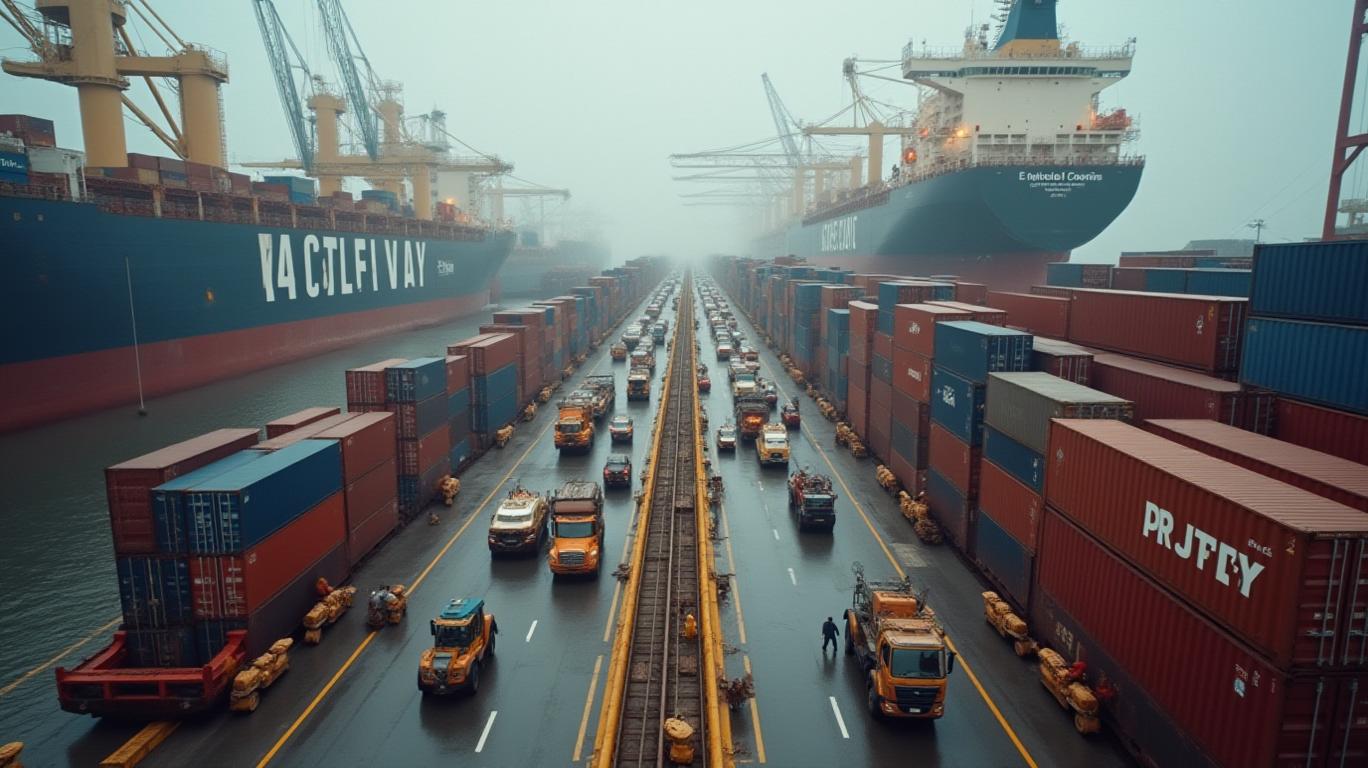Port of LA Faces 10% Container Volume Drop Due to Tariffs
Friday, Apr 4, 2025 11:31 am ET
The Port of Los Angeles, a critical gateway for global trade, is bracing for a significant challenge as tariffs threaten to reduce container volumes by 10%. This anticipated drop, while concerning, is not an isolated issue but part of a broader landscape of geopolitical and economic factors that are reshaping the logistics industry. The port, which has been a beacon of efficiency and growth, now faces the daunting task of mitigating the impact of this reduction while maintaining its competitive edge.
The Port of Los Angeles has long been a linchpin in the global supply chain, handling a staggering 8.6 million teus in 2023. A 10% reduction in these volumes would translate to a loss of approximately 860,000 TEUs, a figure that underscores the potential economic fallout. The port's economic impact is vast, supporting one in nine jobs in Southern California and nearly 3 million jobs nationwide. The ripple effects of such a reduction could be severe, affecting logistics, warehousing, and transportation sectors, and potentially leading to job losses and reduced economic output.

The economic implications are profound. The Port of Los Angeles is responsible for handling $292 billion in cargo value in 2023. A 10% reduction in container volumes could lead to a significant decrease in this economic output, impacting businesses that rely on the port for their supply chain operations. For instance, the top five containerized imports in 2023 included furniture, auto parts, apparel, plastics, and electronics—all critical to various industries in the region. A reduction in the import of these goods could lead to supply chain disruptions and increased costs for businesses, further impacting economic output.
To mitigate the effects of reduced container volumes, the Port of Los Angeles can implement several strategies that could enhance its long-term competitiveness and operational efficiency. One key strategy is infrastructure enhancements and automation. The port can invest in infrastructure upgrades and automated systems for cargo handling. This would allow the port to handle increased volumes more efficiently when demand picks up. As Gene Seroka, the executive director of the Port of Los Angeles, mentioned, "All of our vital statistics are in good shape," indicating that the port has the infrastructure and capabilities to handle additional cargo. By further enhancing these capabilities, the port can ensure smoother operations during peak times.
Diversification of trade routes is another crucial strategy. The port can explore expanding its connections with the Pacific Northwest, as suggested by Bryn Heimbeck, co-founder and president of Trade Tech. Heimbeck noted that the Northwest Seaport Alliance is reporting average terminal dwell times of two and a half days at the ports of Seattle and Tacoma, which is significantly lower than the current dwell times at the Port of Los Angeles. By leveraging these alternative routes, the port can mitigate congestion and ensure more reliable service to its customers.
Improved planning and coordination strategies can also optimize container handling and reduce dwell times. The port could use data analytics to predict peak demand periods and plan accordingly. As Heimbeck pointed out, "The real problem with the current processes is that the terminal doesn't know when the container's going to leave." By improving the port's ability to anticipate and plan for container movements, the port can reduce congestion and improve operational efficiency.
Labor management and training programs are essential for ensuring a skilled and efficient workforce. As Heimbeck mentioned, "a years-long pushback against automation that could potentially increase throughput from union dockworkers at the ports of Los Angeles and Long Beach." By addressing these labor issues and providing training to dockworkers, the port can improve its operational efficiency and reduce the impact of reduced container volumes.
Environmental compliance and sustainability initiatives can reduce the port's carbon footprint and improve its reputation. As noted in the materials, "the global push towards sustainability is influencing operational practices, sometimes slowing port throughput due to stricter environmental compliance requirements." By implementing sustainable practices, the port can enhance its long-term competitiveness and attract environmentally conscious customers.
Collaboration with stakeholders, including shippers, carriers, and logistics providers, can develop joint strategies for mitigating the effects of reduced container volumes. For example, the port could work with carriers to develop alternative routing options or with shippers to optimize their supply chain operations. As Seroka mentioned, "If issues do arise, we will help our supply chain partners in addressing them." By fostering collaboration and partnership, the port can enhance its long-term competitiveness and operational efficiency.
In conclusion, the anticipated 10% reduction in container volumes at the Port of Los Angeles due to tariffs presents a significant challenge. However, by implementing strategies such as infrastructure enhancements, diversification of trade routes, improved planning and coordination, labor management, environmental compliance, and collaboration with stakeholders, the port can mitigate the effects of reduced container volumes and enhance its long-term competitiveness and operational efficiency. These strategies would not only help the port to handle increased volumes more efficiently but also improve its reputation and attractiveness to customers.










